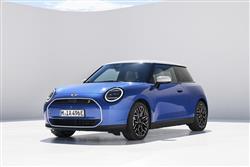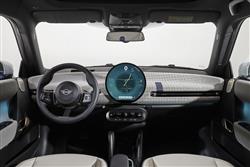MINI Cooper Electric [J01] - ABC Leasing
MINI SMIRKS(some text hidden)
By Jonathan Crouch
Ten Second Review word count: 62
The fun-to-drive MINI formula is alive and well in this, the fourth BMW interpretation of the brand's iconic small hatch. Though petrol power continues, here we focus on the EV variant, now with a dedicated platform that improves packaging and allows for the bigger battery required for greater driving range. But the looks and the drive experience will both feel satisfyingly familiar.
Background word count: 270
EV-powered MINI models have actually been with us for an awful long time now - MINI E prototypes were first produced as long ago as 2008. But, curiously, twelve long years followed before the brand actually put a battery-powered model into production - the R56-era MINI Electric of 2020. Which was particularly strange as the BMW part of this Munich conglomerate had launched a car in this segment (the i3) in 2016. Despite its lengthy development period, MINI's first R56 design was a bit of a bodge job, basically an electric version of the F56 combustion model. But with its successor, this J01 design, things are very different. Ostensibly, there are two versions of the current-era MINI Hatch, but the combustion F66 model we've already tested for you is really just an overhauled version of its predecessor with fresh panelwork and a new interior. It's this J01-era EV design that really is the completely all-new model MINI promised, its underpinnings and drivetrain developed by Spotlight Automotive, a joint venture between BMW and Chinese giant Great Wall Motor. Unlike the combustion Cooper Hatch, it's Chinese-built (alongside its five-door counterpart the identically-engineered Aceman crossover), and all variants now carry a 'Cooper' badge. More importantly, all versions considerably improve on the pitiful EV driving range that characterised the brand's first generation EV Hatch model. And there are now two battery options and it's even possible to now have your Cooper Electric in fiery John Cooper Works hot hatch form. You can find out more about that model - and rivals to this more ordinary version - by downloading the Car & Driving app.
Driving Experience word count: 454
Speed might be the first thing you'll notice here but what was more important for BMW to achieve with this J01-era MINI Cooper Electric was a dramatic increase in drive range. The main reason folk didn't buy the original R56-era Electric Hatch model was that it often struggled to break the three-figure mileage barrier between charges if you drove it hard. That car didn't have a larger battery because it couldn't accommodate one and even if it had been able to, all that bulk would have ruined the brand's trademark agile 'MINI-ness'. So sorting that issue was a huge challenge with this replacement car - so great a feat in fact that the Munich engineers had to join forces with Chinese conglomerate Great Wall Motor to do it. Endless work was done on an all-new Spotlight Automotive platform to allow this car to shrug off the considerable extra bulk of two new batteries much heavier than the original model's little 35.6kWh unit. Either a 40.7kWh pack for the base Cooper Electric E, which powers a 182bhp motor and provides for a range of up to 185 miles. Or a 54.2kWh battery for the top Cooper Electric SE we're trying here, which powers a 215bhp motor and provides for a range of up to 247 miles, a previously unheard-of figure for an electric MINI. The bigger battery is also used by the top John Cooper Works version, which gets a few software tweaks to its motor, boosting output to 258hp yet manages up to 251 miles. So: range is much better; but at what cost to MINI-like agility? After all, the elephant in the room - or, more accurately in this case, beneath the floor - here is kerb weight. Which is up from a relatively featherweight 1,312kg in the first generation model to 1,540kg in the Cooper E and a porky 1,615kg in this Cooper SE. If you've come straight to this car from the old R56-era model, you'll feel the effect of that extra bulk at speed through tighter turns - though not quite as much as you might expect to. The engineers have had to engineer the suspension very carefully to achieve that result (it's slightly softer in this heavier SE variant) and they don't want owners playing around with the end result, which is doubtless why (unlike with the combustion version of this car) you can't have adaptive suspension - which is always a bit of an issue with a firm-riding MINI. Fortunately, you can just about live with the pre-determined passive damping settings for suburban work and on your favourite secondary back-double route, they're well chosen to preserve most of the kart-style handling MINI wants to still be famous for.
Pictures (High res disabled)

.jpg)
.jpg)
.jpg)
.jpg)
.jpg)
.jpg)
.jpg)

Scoring
Category: Compact Car
| Performance | |
| Handling | |
| Comfort | |
| Space | |
| Styling | |
| Build | |
| Value | |
| Equipment | |
| Economy | 70% |
| Depreciation | 80% |
| Insurance | 60% |
| Total | 68% |